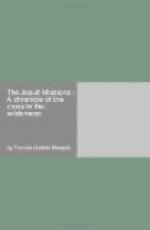The Jesuits themselves were busy with the education of the Indians and had already established a college and seminary for the instruction of young converts. The colony, however, was not growing. The Hundred Associates had not carried out the terms of their charter. There were less than four hundred settlers in the whole of New France, and only some three hundred soldiers to guard the settlements from attack. Canada as yet was little more than a mission; and such it was to remain for another twenty and more years.
CHAPTER VI
THE MARTYRS
We have observed that the Hurons were at war with the Five Nations and that Iroquois scalping parties haunted the river routes and the trails to waylay Huron canoemen and cut off hunters and stragglers from their villages. When or how the feud began, between the Iroquois on the one side and the Hurons and Algonquins on the other, no man can tell. It antedated Champlain; and, as we have seen, he had involved the French in it. There were, no doubt, many bloody encounters of which history furnishes no record. At first the warriors had fought on equal terms, the weapons of all being the bow and arrow, the tomahawk, the knife, and the war-club. But now the Iroquois had firearms, procured from the Dutch of the Hudson, and were skilled in the use of the musket, which gave them a great advantage over their Huron and Algonquin foes.
On the south-east frontier of Huronia, about four miles from Orillia, stood a town of the clan of the Rock, Contarea, a ‘main bulwark of the country.’ The inhabitants were pagans who had resisted the missionaries, and refused them permission to build a chapel, not even deigning to listen to their appeals. In the early summer of 1642 the people of Contarea were living in fancied security; and when runners brought word that in the forests to the east a large force of Iroquois were encamped, the Contarean warriors felt confident that, from behind their strong palisades, they could resist any attack. No Iroquois appeared; and, believing the rumour false, many of the warriors left the town for the accustomed hunting and fishing grounds. Suddenly, early on a June morning, the sleepy guards were roused by savage yells. The Iroquois were upon them. The alarm rang out; the towers were manned, and the palisades lined with defenders. But in vain. Arrows and bullets swept towers and palisades, and through breaches made in the walls in rushed a horde of bloodthirsty demons. In a few minutes all was over; the town became a shambles; young and old fell beneath the tomahawks of the infuriated invaders. Then the torch! And the Iroquois hied them back in triumph to their homes by the Mohawk, exulting in this first effective blow at the enemy in his own country.
When news arrived of the destruction of Contarea, there was wild alarm in the mission towns. But it was no part of the Iroquois plan to attack at once the other Huron strongholds. Huronia could wait until the tribes of the St Lawrence and the Ottawa, allies of the Hurons, should be destroyed. Then the Five Nations could concentrate their forces on the Hurons.




